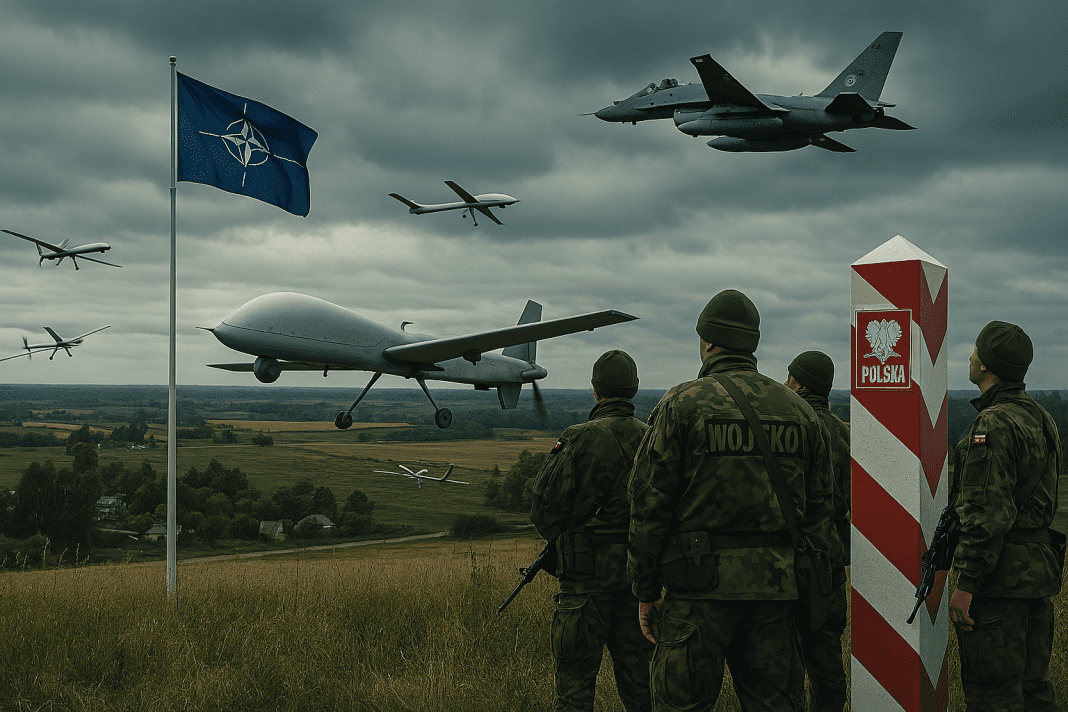Tensions between Russia and NATO have reached a new high after an unusual and alarming incident in Europe. On September 9, twenty-one Russian drones crossed into Polish airspace. This marked the first large-scale intrusion by Russia against a NATO member since the end of the Cold War, raising questions about the alliance’s readiness to defend its eastern border.
An Unprecedented Incident in NATO’s Eastern Flank
Poland quickly assessed the incursion as intentional. Polish authorities detected the drones over rural areas, and although the drones carried no explosives, officials considered their presence a clear violation of Poland’s territorial integrity. Russia, however, denied any intent to attack and described the flight as part of a broader struggle with the West.
The timing of the incursion mattered. Europe already remains on high alert due to Russia’s ongoing war in Ukraine, and the drone flight put NATO’s ability to respond under close scrutiny. Russian officials later claimed that NATO is effectively at war with Russia, while the alliance consistently stated that it does not participate directly in the Ukraine conflict.
NATO warns of risks in setting up no-fly zone over Ukraine amid rising Russian attacks
NATO Takes Measured Action Against the Drone Threat
Poland responded swiftly by invoking Article 4 of the NATO treaty. This clause lets member states consult whenever they believe another member’s security faces a threat. However, NATO did not activate the stronger Article 5, which obliges collective defense. This decision reflected caution within the alliance and emphasized that it was not yet ready to escalate to full-scale military action.
NATO also took several defensive measures. The alliance deployed additional air assets to patrol the eastern flank, including fighter jets, surveillance aircraft, and helicopters from multiple member states, increasing protection over vulnerable areas. Leaders presented these steps as precautionary rather than punitive against Russia.
Trump threatens NATO with ultimatum: no unity, no sanctions on Russia
The United States maintained a careful stance, suggesting that Russian drones may have crossed into Poland by accident. Although measured, this statement raised questions about NATO’s unity and whether member states could present a strong, coordinated response. Meanwhile, militaries across Europe began reviewing strategies to counter low-cost drones, which Russia has widely used in the war in Ukraine.
The drones flew unarmed over areas that minimized the risk to civilians.
Analysts say this indicated a deliberate choice by Russia to provoke NATO without creating a dangerous escalation. These drones, often used in Ukraine to distract air defenses, allowed Russia to gather information on NATO’s detection and response systems.
Testing NATO Boundaries and Readiness
The incursion highlighted more than just aerial vulnerabilities; it tested NATO’s political and military limits. By carefully selecting unarmed drones and flight paths over rural areas, Russia managed to gauge the alliance’s reaction without triggering an automatic military response.
Debris from at least one drone caused minor property damage in a Polish village, showing that even non-lethal incursions carry risks. Experts note that these incidents allow Russia to probe NATO’s readiness and measure how far the alliance can be pushed without escalating into open conflict.
The situation also exposed NATO’s internal limits. While the alliance could quickly deploy additional forces, the overall response was restrained, reflecting the need for consensus among member states. Each country weighs the risks of escalation, particularly because Russia possesses a nuclear arsenal. This has kept NATO cautious about moving beyond defensive measures.
NATO vows strong response as Russia and Belarus launch massive Zapad 2025 war games near Poland
Observers emphasized that Russia’s calculated approach—unarmed drones over non-populated areas—demonstrates careful planning. Moscow successfully tested NATO’s alertness and defensive coordination while avoiding casualties or major political fallout. The incident raises questions about how future provocations might be measured and addressed, with NATO now under scrutiny for its response capabilities.
Even as NATO strengthened its eastern defenses, the incursion served as a reminder that such provocations could occur repeatedly. The alliance is now closely monitoring airspace and evaluating the effectiveness of drone defenses, signaling a shift toward greater preparedness on the eastern flank.

